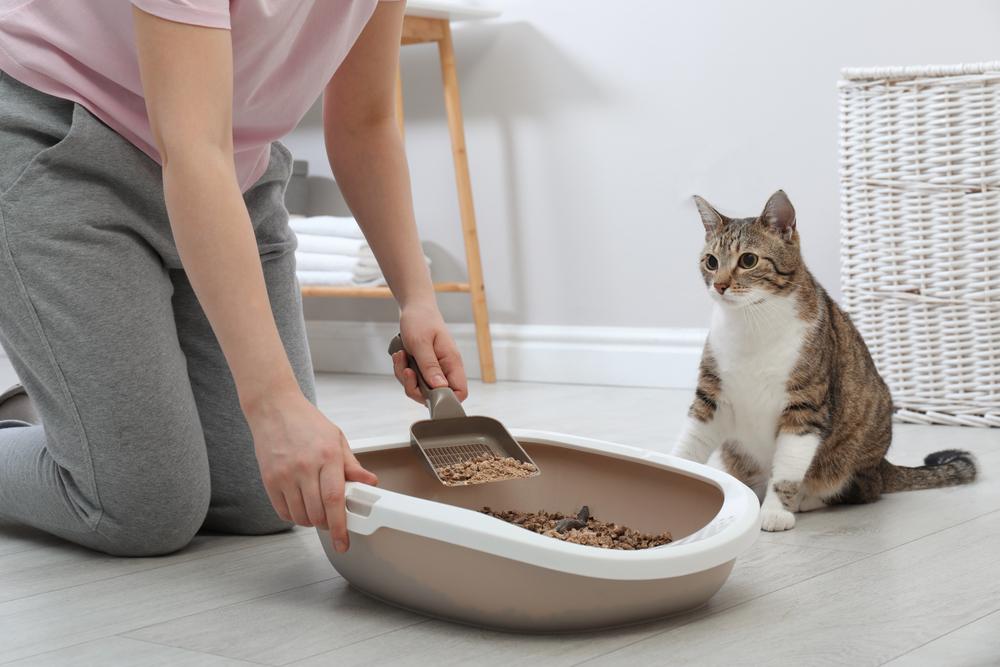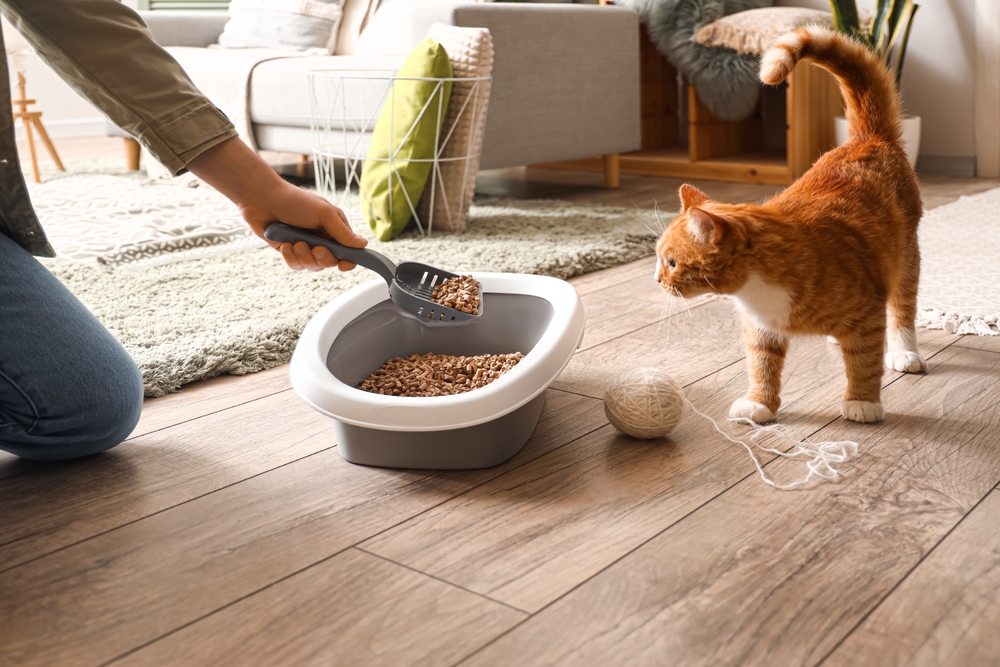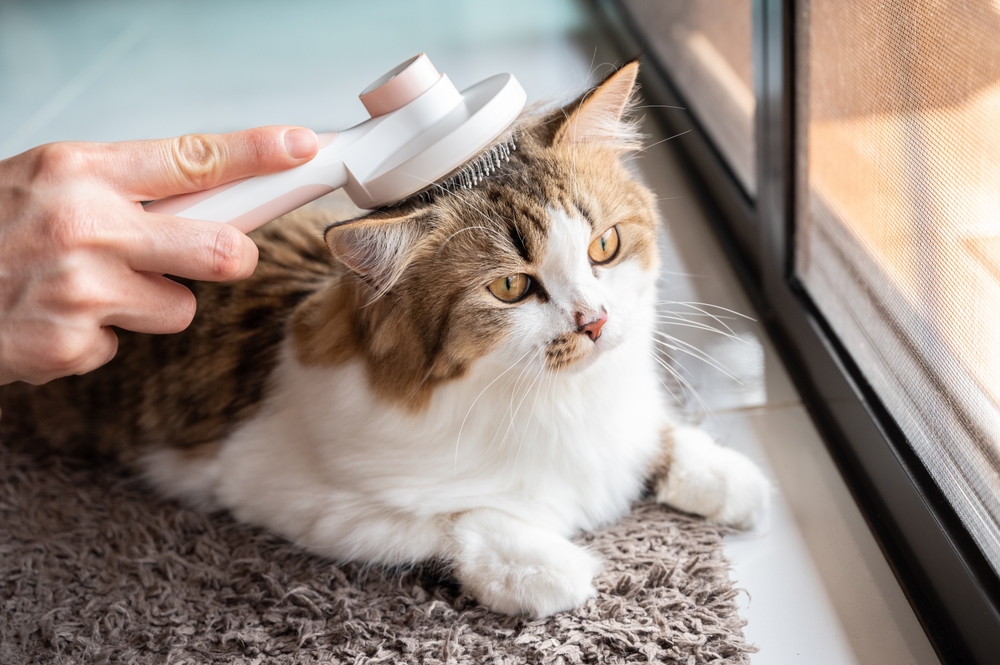Happy cat, happy life?
Our little bundles of fluff bring so much joy into our lives, so it’s only fair to give back and enrich their lives as much as we can. Like people, cats have a wide range of negative emotions, including depression, boredom, and loneliness, waiting to lash out if we don’t make an effort to make our felines happy.
The good news, though, is that cats aren’t as complicated as us, and keeping them happy isn’t such a difficult task once you get the hang of it. All they really need is for us to satisfy their basic needs, like shelter, food, and entertainment, and they’ll give you endless head bumps and purrs in return.
But if you want a happy cat like a responsible pet parent but have no idea what to do and where to begin, here are 16 ideas you can do right now to put a smile on your feline’s face!

Clean up regularly
Cats are naturally clean animals. But some felines are particularly finicky about their territory’s cleanliness. You might notice that your normally happy cat won’t use the litter tray if you haven’t cleaned it. Try to scoop up any solids whenever you see them, and get rid of wet litter once a day.
You should also thoroughly clean your kitty’s litter box weekly to get rid of stubborn dirt and litter that’s stuck inside the tray. Did you know that there’s an enzyme cleaner that does all the dirty work?
The “Hepper Advanced Bio-Enzyme Pet Stain and Odor Eliminator Spray” permanently eliminates the worst stains and smells and offers a 100% satisfaction guarantee!
Invest in good scratching posts
Happy cats have a natural need to scratch. It helps their claws by sharpening them and maintaining them trim, but they also scratch for a bunch of other reasons, including to mark territory and stress relief. If you don’t provide your kitty with an appropriate spot to scratch, they’ll find their own, which generally involves carpets, furniture, and other undesired surfaces, including your favorite clothes!
Try to buy at least one high-quality scratching pad, post, or other scratcher. If your feline is already scratching your couch, place the scratcher near it. Otherwise, choose a spot your cat likes to regularly hang out and place it here.
Don’t know what to buy? The Hepper Hi-Lo Modern Cat Scratcher has a stylish design, and it’s functional, making it the ultimate scratching spot for your cat. Unlike most cat toys that get ignored around the house, this one’s a crowd-pleaser for most happy cats.
Its thick textured cardboard, three configurations, and solid birch plywood frame encourage your cat’s natural scratching instincts, so they keep away from your precious furniture, among all other things they shouldn’t be scratching. The Hi-Lo is like your furniture’s mini guardian, keeping it safe while looking trendy and sleek.
Choose healthy snacks
Treats can be useful training tools, but giving your happy cat a treat every once in a while to show you care is also nice. If you give them treats regularly, make sure they’re healthy and modify your cat’s remaining caloric intake accordingly.
Obesity is a big issue for felines, and it can be difficult for your cat to lose weight once they’ve piled on the extra pounds. Try to look for treats that are low in calories and ideally offer some nutritional value. If you use them for training purposes, think about the calories when calculating your cat’s daily food allowance.
It’s best to consult a vet for more information on your happy cat’s daily food intake. Don’t forget that their nutritional needs will alter throughout their life. So, a plan that worked for them in the past may need to be revised to ensure your pet remains healthy without compromising their nutritional welfare.
Install a climbing tree
We all know that happy cats love to climb. If they spend any time outdoors, they’ll spend a lot of time climbing fences, trees, and even buildings. If your cat is an indoor cat, though, you can still provide climbing options.
A climbing tree generally has a primary column with platforms around the column leading up. It may also include scratching posts, tunnels, hanging toys, beds, and other items. You can add floating shelves with some carpet and fix them to the walls, and your cat can use them to climb and reach elevated positions.
Create window perches
Cats love looking out the window. They enjoy watching other animals, birds, and people as they go about their daily lives. It’s like your kitty’s equivalent of watching TV. The window ledge has a clear view, so your cat can sit and watch to its heart’s content.
So why not buy a bed that attaches to the top of the window or radiator? Alternatively, you can also move the cat tree next to the window so your happy cat can perch itself on the cushioned platform and watch the world. Just remember that excessive exposure to the sun’s rays can be an issue for cats.
This risk is even higher on hairless breeds, who absolutely love sunbathing! Still, the sun’s rays are dangerous for all cats because many parts of their face are naturally hairless or contain light hairs.

Use interactive toys and puzzle feeders
You can provide your cat with enrichment in its life even when you’re not available to play with them. Other than buying the usual wand toys, look for interactive toys as well.
Your kitten has to manipulate them to find the treat concealed inside. Show your happy cat the treats inside, and begin with the easiest setting. When they master the easy toy, they move on to something a bit more difficult.
Create a routine
Felines like having a routine. So, you should try to stick to some kind of schedule that’s as regular as possible with your kitten. They expect to be fed at around the same time every day, and they’ll recognize when it’s time for you to leave the house, for bed, and even when it’s time to sit and cuddle up while watching some TV at the end of a long day.
Some cats can get stressed or anxious if their routine gets messed with, but it’s okay to feed them an hour or so later than usual every once in a while. The amount of stress a happy cat would experience from a change depends on each individual cat.
Contrary to popular belief, not all of them are creatures of habit as pets. In fact, some appreciate spontaneous play sessions every now and then!
Make sure the water’s always fresh
We all need water to survive. If you feed your pet canned food, your kitten will get some of the water they need from the moisture, but you should always provide them with a bowl of water. Make sure the water is easily accessible, but keep it away from the litter box.
Some happy cats also don’t like it when their water is too close to the food. It should also be fresh, so you should change it at least once daily.
Even with fresh water that’s easily accessible, though, some felines are fussy and reluctant to drink water straight from the bowl, and you may need to consider a cat water fountain.
A good one many pet parents recommend is the Hepper Stainless Steel Cat Water Fountain, which has three different flow modes, advanced triple filtration, and an automatic shutoff feature.
Buy them some new toys
Happy cats love getting toys. They enjoy chasing small items around the house because it activates their prey instinct. Small, crinkly toys look like insects or rodents, and the crinkling noise reminds them of the sound prey would make while running.
You might find your kitten quickly bored of new toys, but that doesn’t mean you have to toss them away. You can provide several, and when you notice that they stop playing with one or more, remove them and put them in a box somewhere.
Replace them with new toys or take out an old one from the closet. You can keep refreshing the toy selection this way, ensuring your adorable fluff ball has appealing toys while decreasing your spending on them.
Try training them
Most cat parents know that their felines can easily be taught to use their litter box instead of just doing their business wherever they can. But most healthy and happy cats can be trained to do much more than that. You can even use treats and toys to help you teach your cat to play fetch.
Sit a little stretch away and throw a toy. When your cat picks it up, encourage them to come back. If they come with the toy, give them a treat and throw it again. It can take a bit of time to master this trick. But it’s just one of many tricks you can teach your kitten. Some even train their cats to spin around, high-five, or lie down.

Get a better quality cat litter box
Litter boxes are crucial for all happy cats, even those that get to go outside. It’s commonly accepted that you should have one box per cat and another extra. This allows your cats to choose which one to select and ensure it’s clean.
The litter boxes should be placed in different rooms and be easily accessible. At least one side of the box should be against a wall and not be set in busy areas. Besides the standard litter trays we all know about, you can get a self-cleaning model. Selecting a suitable quality litter your cat values is also an integral step in the cat litter process.
Offer them bags and boxes
It isn’t just toys that felines like to play with. If you’ve ever had a happy cat, you already know that they love sitting on paper and hanging out in empty cardboard boxes. Some even like playing and climbing in paper bags.
But before you offer up that paper bag to be sacrificed, make sure that anything you give your kitten is safe, and take into consideration that your cat might prefer to eat the bag or box rather than play with it.
Caution is always strongly advised when it comes to bags. And remember that plastic bags can be dangerous for cats, especially if they aren’t supervised and left alone with them.
Buy comfy beds for your happy cats
Our feline pals can sleep for a whopping 16 hours a day, and while yours may enjoy spending time napping in the laundry basket or in your sock drawer, providing your kitten with a bed will not only give them somewhere to sleep but can also give them a little space to call their own.
There are many kinds of cat beds, from cat caves to doughnuts. But some happy cats love nothing more than sleeping in a creased box. Keeping a happy cat feeling comfy and secure when you’re away will keep them well-rested and ready to play when you come back.
The Hepper Nest, for example, is a modern cat bed developed to meet the exact needs of felines. Its high sides will offer a sense of security, and the bowl shape will give support like a warm hug from their mother.
Take your cat on a walk
Walking a pet is often associated with canines. But trust me, you can walk your cat too. Buy a leash and harness, put them on, and try taking your happy cat for a walk around the block. That is after you train them to get accustomed to the leash and harness inside.
Try to choose a quiet area where you aren’t likely to see any dogs. Your cat might get along well with dogs, but some can be aggressive. And you never know what you’ll encounter when you’re out and about with your furry feline pal!
Don’t rule out catnip
Catnip, a.k.a. Nepeta cataria, is a member of the mint family, and, to us, it’s innocent. But, it can send happy cats into a tizzy when they get a whiff of it and calm them down when they eat it. Your kitty will likely respond to catnip by rubbing, rolling, and flicking it around. Just know that not all cats react to catnip.
Roughly a third of all felines don’t even have a reaction to it. Also, not all cats react in a positive way to catnip. In a stricter sense, catnip is toxic for cats because excess consumption can lead to health issues in some. So don’t overdo it! You can buy a catnip-scented toy or bags of catnip and sprinkle a small amount on the floor.
But you need to make sure that your cat isn’t affected negatively by the herb before deciding to do so. Let them smell it first and see their reaction.
My favorite catnip toy is Hepper’s Catnip Stick Toy because it’s available in a fantastic range of colors, it’s handmade in the US and is strong enough to withstand your happy cat’s sharp claws. Best of all, you won’t find any unnatural filler in it. Just 100% organic catnip!

Groom regularly
Routine grooming helps clean your happy cat’s coat by removing loose dirt, fur, and other debris. It also helps spread all those natural oils in your cat’s coat, preventing their hair from drying out and keeping it in tip-top shape.
Grooming is especially valuable for long-hair cats because it discourages knotting, but it should be a part of your schedule with any type of feline. Another benefit of routinely brushing your cat is that the activity can help develop a bond between you.
Begin when your happy cat is still little and maintain a regular schedule, ideally grooming at least twice a week but every day for some breeds. Another advantage of grooming your kitty regularly is that you may pick up cues if something is off with their health.
For instance, if your cat is in pain when you run your hand over a specific part of their body or if you find a strange growth somewhere, it might be time to schedule a vet appointment to examine the area professionally. Here’s a helpful tool to help you groom your fluff ball!
Any thoughts on these happy cat tips? Or maybe you have some of your own you’d like to share. Let me know in the comments section below!
And if you enjoyed this article, I think you’ll also like: Help Your Chubby Cat Slim Down: 6 Easy Tips













One Response